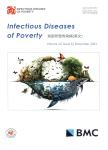Cutaneous leishmaniasis control in Alta Verapaz (northern Guatemala): evaluating current efforts through stakeholders' experiences
Cutaneous leishmaniasis control in Alta Verapaz (northern Guatemala): evaluating current efforts through stakeholders’ experiences作者机构:Center for Health Studies(CHS)Universidad del Valle de Guatemala(UVG)18 Avenida 11-95zona 15V.H.3Guatemala CityGuatemala Instituto Nacional de Salud Publica(INSP)CuernavacaMexico Communicable Diseases and Environmental Determinants of Health DepartmentPan American Health OrganizationWashingtonDCUSA. Leishmaniasis Sub-ProgramNational Ministry of Health of GuatemalaGuatemala CityGuatemala Department of Global Health and Infection(GHI)Brighton and Sussex Medical School(BSMS)University of SussexBrightonUK.
出 版 物:《Infectious Diseases of Poverty》 (贫困所致传染病(英文))
年 卷 期:2021年第10卷第3期
页 面:14-25页
核心收录:
学科分类:1004[医学-公共卫生与预防医学(可授医学、理学学位)] 1002[医学-临床医学] 1001[医学-基础医学(可授医学、理学学位)] 10[医学] 100206[医学-皮肤病与性病学]
基 金:funded by the UNICEF/UNDP/World Bank/WHO Special Program for Research andTraining in Tropical Diseases(TDR),a program co-sponsored by the World Health Organization(WHO)as part of the call for proposals:'Embedding Research for the Sustainable Development Goals(ERSDG) initiative.This funding source has not influeneed the collection,analysis,or interpretation of data.
主 题:Cutaneous leishmaniasis Control effort Qualitative evaluation Stakeholders'experiences Alta Verapaz Guatemala
摘 要:Background:Cutaneous leishmaniasis(CL),endemic in Guatemala,mostly affects poor people living in the northern region.A national control program that ineludes surveillanee,diagnose,and treatment offered free of cost by the Ministry of Health(MoH)has been in place since 2003.However,the incidence is increasing and treatment rates are not optimal,suggesting that current efforts are not being effective.This study aimed to understand barriers and facilitators of CL control in Guatemala as experienced and perceived by key stakeholders in order to comprehend what works well and does not and suggest evidence-informed interventions.Methods:The study was conducted in the Coban municipality,the most endemic of Guatemala,situated in the Department of Alta Verapaz.Data were collected during May and June 2019 via focus groups and semi-structured interviews with key stakeholders,including local and national health personnel and residents of four communities of the endemic region.Thematic and content analysis of the collected data was conducted using NVIVO.Results:Three overarching issues hamper the effectiveness of current CL efforts:resource scarcity,treatment challenges,and knowledge-action gaps.Scarce economic resources from the MoH and community residents negatively impact incidence,detection of cases and treatment rates in that preventive action is insufficient and healthcare access is low.In addition,local health workers often lack specialized CL training and access to the national CL control guidelines.With regards to the population living in the study area,misunderstanding of disease causation,shame associated with CL lesions,treatment pain fear,and long(often uncertain)waiting times for diagnose and treatment negatively affect people s willingness to seek help,treatment adherence,and their trust on the healthcare provided.Conclusions:Culturally sensitive CL preventive action must be developed.Given the scarce economic resources available for CL control in the country,the involvement of trained community health workers and the inelusion of thermotherapy as a treatment option is also advised.Other cost-effective actions include:ensuring all health workers receive CL training and have access to national CL control guidelines,improving national procurement system to avoid treatment shortages,and provision of motorized vehicles to increase active surveillance and treatment rates.



